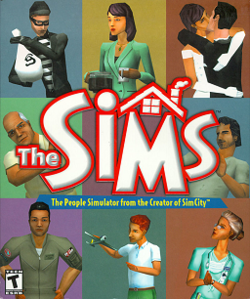The Sims: House Party
| The Sims | |
|---|---|
 |
|
| Developer(s) |
Maxis Edge of Reality (consoles) |
| Publisher(s) | Electronic Arts |
| Designer(s) | Will Wright |
| Composer(s) |
Jerry Martin Marc Russo Kirk R. Casey Dix Bruce |
| Series | The Sims |
| Platform(s) | Microsoft Windows, Mac OS, PlayStation 2, GameCube, Xbox |
| Release |
Microsoft Windows Mac OS
GameCube & Xbox |
| Genre(s) | Life simulation |
| Mode(s) | Single-player |
| Aggregate scores | |
|---|---|
| Aggregator | Score |
| GameRankings | (PC) 89.74% (PS2) 81.05% (Xbox) 81.53% (GCN) 85.80% |
| Metacritic | (PC) 92/100 (PS2) 83/100 (Xbox) 84/100 (GCN) 85/100 |
| Review scores | |
| Publication | Score |
| AllGame | |
| GamePro | |
| GameSpot | 9.1/10 |
| IGN | 9.5/10 |
| ActionTrip | 9.0/10 |
| Awards | |
|---|---|
| Publication | Award |
| GameSpot | Game of the Year |
| Game Developers Choice Awards | Game of the Year |
| IGN | Best Simulation |
The Sims is a 2000 strategic life-simulation video game developed by Maxis and published by Electronic Arts. It is a simulation of the daily activities of one or more virtual people ("Sims") in a suburban household near a fictional city. The game's development was led by game designer Will Wright who is also known for developing SimCity. The Sims original series had a total of seven expansion packs produced, with expansions adding new items, characters, skins, and features. The game has had several subsequent sequels; The Sims 2, The Sims 3 and The Sims 4.
The Sims uses a combination of 3D and 2D graphics techniques. The Sims themselves are rendered in 3D, whereas the house and all its objects are pre-rendered and displayed diametrically.
While gameplay occurs in the game's live mode, the player may enter build mode or buy mode to pause time and renovate the house or lot. When the game begins, each family will start off with §20,000 Simoleons (regardless of its number of members). These funds can be used to purchase a small house or vacant lot on the Neighborhood screen. Once a lot is purchased, a house may be constructed or remodeled in Build mode, and/or purchase or move furniture in the Buy mode. All architectural features and furnishings customizable in the Build and Buy modes follow a square tile system in which items must be placed on a tile. Walls and fences go on the edge of a tile and can follow the edge of the tile or cross it, but furniture items cannot be placed on either side of a crossed tile. The base game contains over 150 items including furniture and architectural elements.
...
Wikipedia
